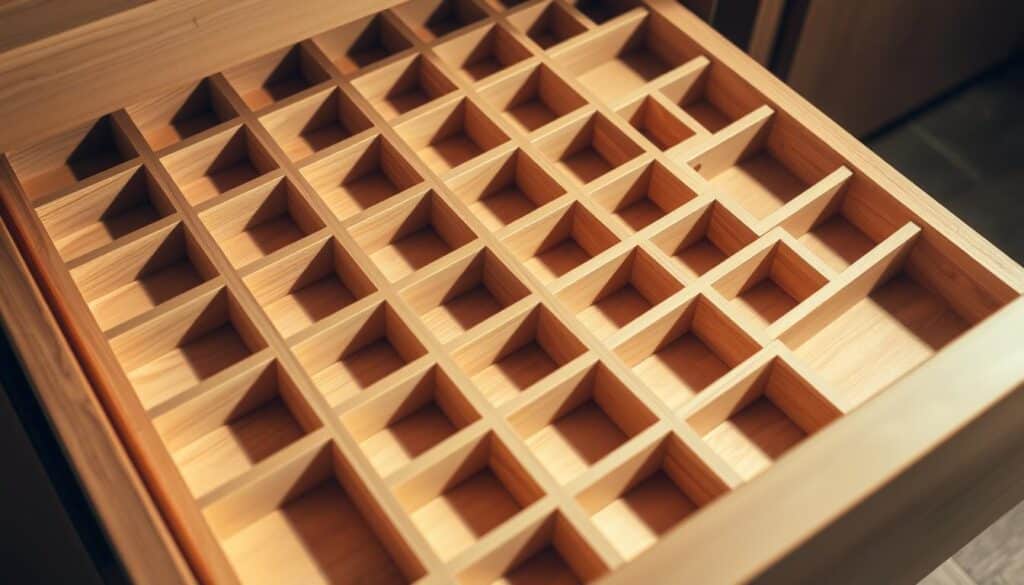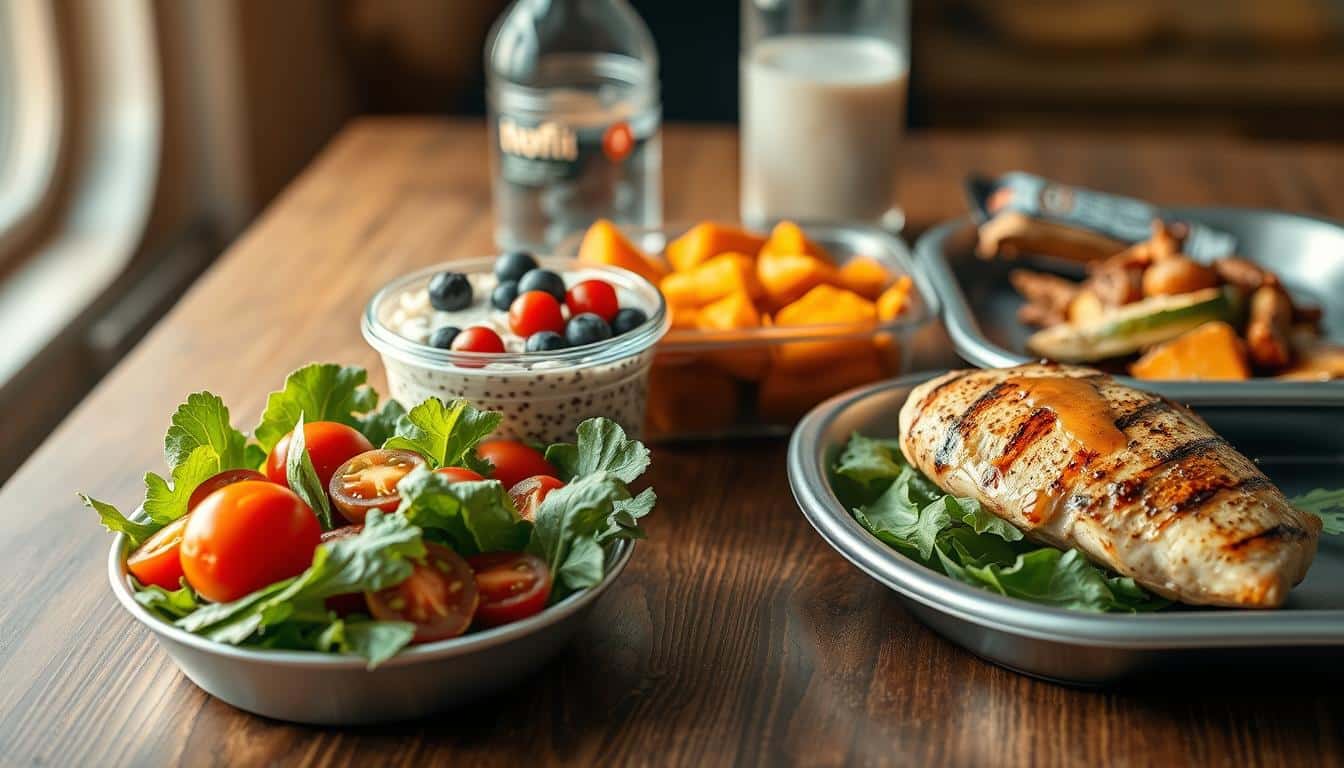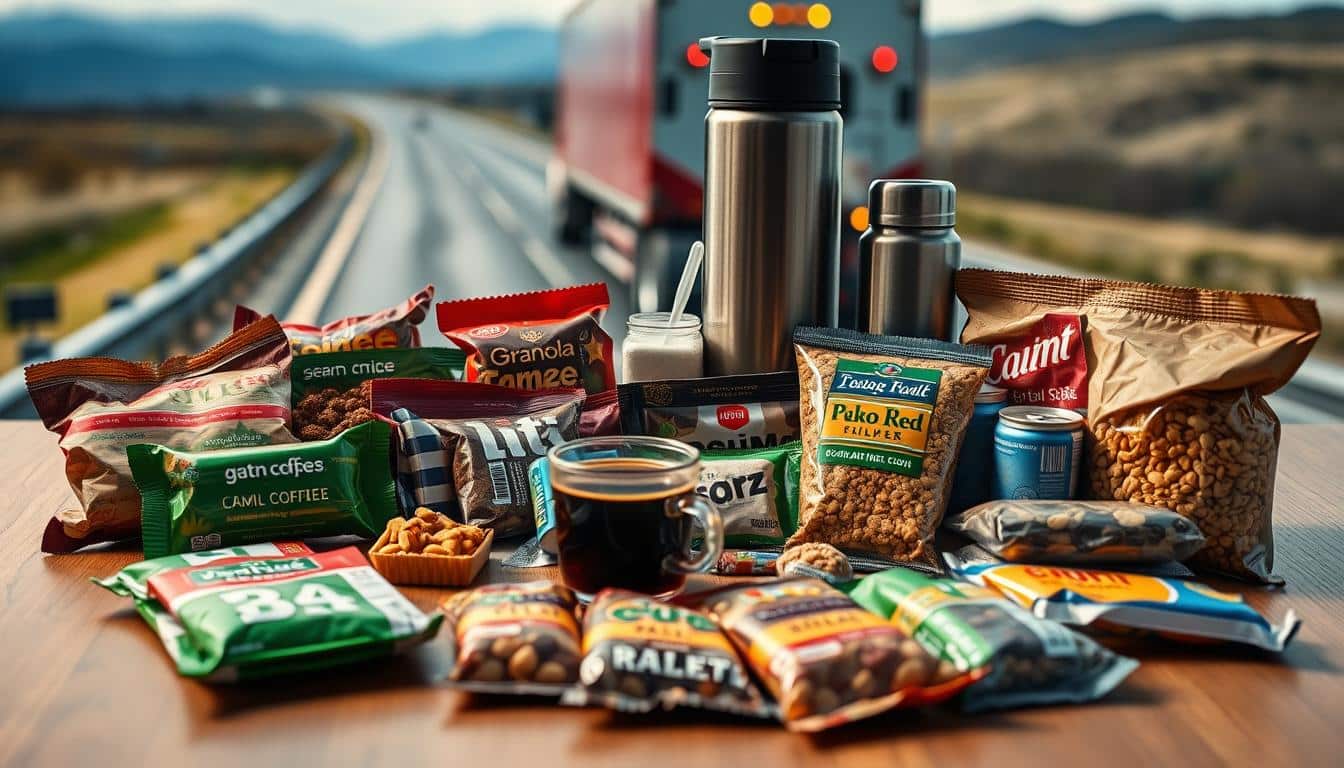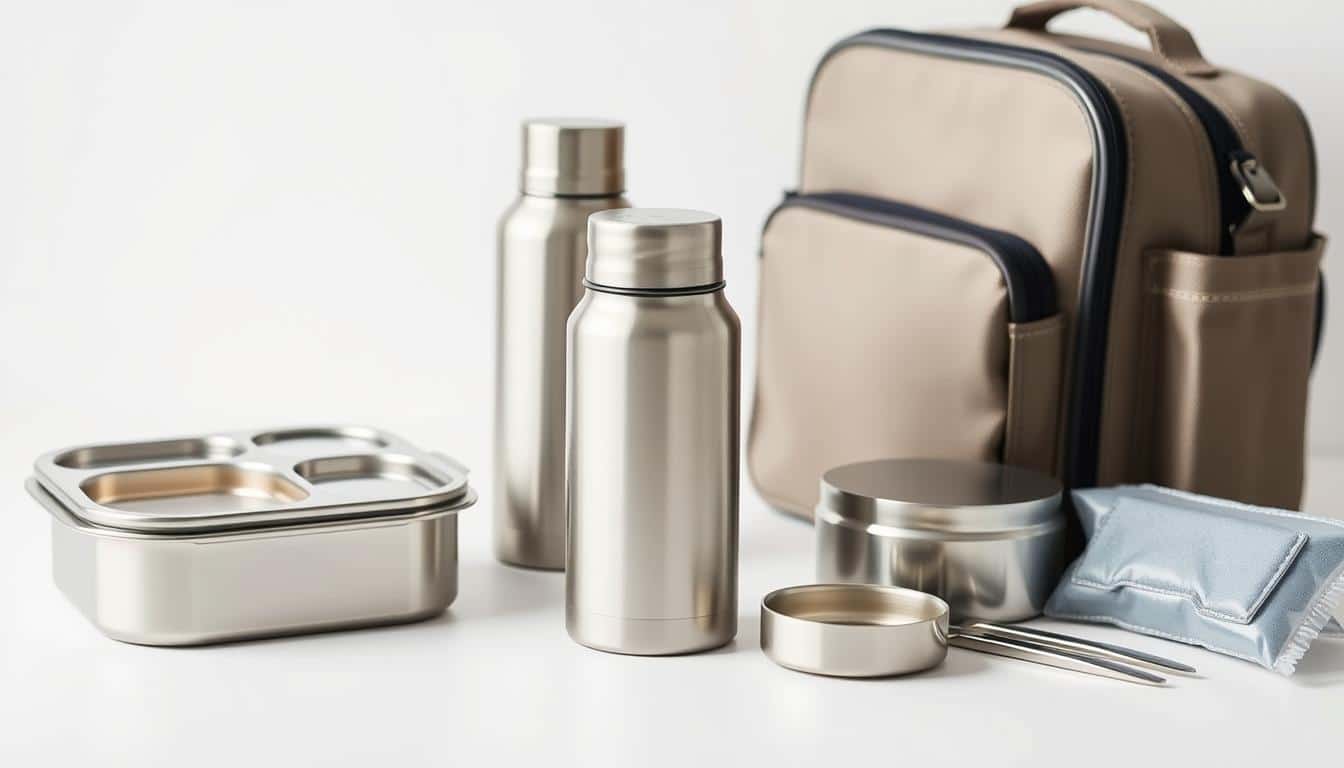Cluttered cabinets and crowded counters frustrate many homeowners. Today’s kitchens are more than cooking areas. They’re also spots for homework and hosting friends, needing storage that brings peace and flow.
Simple changes can greatly improve your space. Hang spices on door backs, oven mitts on cabinet sides, and use organizers on under-sink doors. These steps clear shelf and counter areas.
People love adding custom pantries, pullout baskets, corner drawers, and hidden spots for appliances, as seen on Houzz. These ideas make food and cookware easy to see and reach, keeping things tidy.
Here, you’ll find affordable tricks and big changes suitable for any kitchen size. Keep reading for tips that transform unused spaces into valuable storage. These ideas offer effective, daily food storage solutions.
Maximizing Small Kitchens with Creative Food Storage Solutions
Small kitchens need smart ideas. Making a few changes can turn tight spots into clever storage areas. This keeps counters clean and makes cooking easy.
Use the back of doors for compact storage
- Put slim racks on cabinet and pantry doors for spices, oils, and oven mitts. Using the back of the door keeps often-used items easy to see and reach. It does this without taking up shelf space.
- Get adjustable pocket organizers. They let glass jars and small boxes fit well. This helps you avoid having too many of the same item by making what you have easy to see.
Under-sink door organizers for cleaning supplies and bulk items
- Attach caddies or narrow bins to under-sink doors for holding sprays, sponges, and bulk paper goods. Under-sink organizers clear the cabinet floor. This makes room for big items like trash cans or refill packs.
- Add sliding trays and clear containers to stop spills and make things easier to reach. A simple change can create a lot more usable space.
Wall-mounted racks and slim organizers to free up counter and cabinet space
- Use wall-mounted kitchen racks for pots, pans, and utensils. This creates storage up high and keeps counters open. Open shelves and magnetic strips keep tools handy without filling up drawers.
- Thin pullouts and narrow shelves next to ranges or fridges are great for oils, baking sheets, and cutting boards. Combine these with back-of-door and under-sink options. This creates a well-organized small kitchen storage plan.
Hidden and Seamless Pantry Ideas for a Clutter-Free Kitchen
Hidden pantry ideas make your kitchen look clean and open. In small homes, you can hide storage behind doors or use a shallow closet. This keeps your kitchen neat.
Walk-in pantry designs are versatile. Even in a small space, you can have shelves, baskets, and bins. They hold your food, gadgets, and big items. Doors that blend in help keep things tidy but accessible.
Butler’s pantries are perfect for hosting. They connect the kitchen and dining area, holding dishes and drinks. With everything in reach, parties go smoothly.
- Turn a coat closet into pantry space with tall shelves and clear bins.
- Sliding trays and baskets help you see what you have, avoiding extra buys.
- Door-mounted racks are great for spices and often-used items, saving shelf space.
Adding a pantry without big changes is smart. Doors that match your kitchen hide storage well. Light and labels help you find things like snacks and baking stuff quickly.
Good hardware is key for a lasting pantry. Smooth slides and strong shelves mean a tidy kitchen. This makes life easier every day.
Toe-Kick Drawers to Use Every Inch of Space
Toe-kick drawers make the most of wasted space at the bottom of cabinets. They are perfect for storing things like baking sheets, serving trays, and seasonal items out of view. These drawers often open with just a tap of the foot, making them easy to use without your hands.
The best items to store in these drawers depend on their size. Things like cookie sheets and cutting boards fit perfectly. They are also great for storing seasonal linens, small appliances you don’t use often, and extra placemats. To keep everything organized, you can use dividers.
- Sheets and trays: store vertically for quick retrieval.
- Seasonal items: label compartments for easy rotation.
- Flat kitchen gear: tuck baking pans out of cabinet clutter.
There are different design considerations for new kitchens and remodels. In new kitchens, you can plan for toe-kick drawers from the beginning. But adding them to an existing kitchen might require more space and changes to the cabinets. It’s a good idea to talk to a cabinetmaker early on to figure out the costs and how it can be done.
The hardware you choose is key for the drawers to work well and last long. Drawers that close softly won’t slam and are safer to use. Slides that let the drawer fully extend make it easier to grab things from the back. Opting for high-quality brands like Blum or Häfele makes sure your drawers work smoothly.
- Plan drawer depth and internal dividers before ordering cabinets.
- Discuss frame clearance and toe-kick height with your carpenter for retrofit work.
- Prioritize soft-close drawers and full-extension slides to improve longevity and access.
Toe-kick drawers that are well designed fit seamlessly into your kitchen. They provide extra storage without changing how your kitchen looks. Spending a bit more on good hardware and planning makes your kitchen more convenient every day.
Vertical Pull-Out Pantries for Narrow Gaps and Tight Spots
Make the most of tight spaces with a vertical pull-out pantry. It’s great for keeping things like tall bottles and baking sheets easy to find and reach. These pantries take away the hassle of searching through deep shelves.
Putting a pull-out pantry near where you prepare food or next to the fridge is smart. It makes grabbing what you need fast and effortless. And if it’s near the sink or stove, it saves time by keeping spices and cooking oils close.
Think about these custom options to make your pantry even better:
- Built-in spice pullout racks for jars and small bottles.
- Adjustable pantry baskets that slide and reconfigure for cans, snacks, or cleaning supplies.
- Custom shelving heights to hold mixers, soda bottles, or tall vinegar bottles.
Combine fixed shelves with adjustable baskets for a setup that can change as your needs do. Adjustable baskets are especially good for heavy items—they help avoid messes when pulling the pantry out. A spice rack pull-out also keeps your counter free of bottle clutter.
For the smallest spaces, choose slim pantries that extend fully. This way, everything is easy to see and reach without losing space. Pick sturdy hardware to prevent wear and tear. A well-designed vertical pull-out pantry makes any narrow spot highly functional and neat.
Corner Drawers and Solutions That Beat Lazy Susans
Corner cabinets often turn into places we don’t use much. Corner drawers make everything easy to reach and organize. They are a great choice instead of lazy susans, especially when you want to see and reach things easily.
Benefits of full-extension corner drawers for accessibility
Full-extension drawers stop the need to crawl into cabinets. They hold pots, bowls, and appliances on easy-to-pull platforms. Brands like IKEA and KraftMaid show these drawers mean less dropping and easier reaching compared to swirling shelves.
Custom cabinet considerations and depth planning
Adding corner drawers means you might need custom cabinets. Make sure the drawers are deep enough for pots but shallow for utensils and spices. Getting the size right means your drawers won’t hit other doors and will slide smoothly on tracks from brands like Blum or Accuride.
Cost vs. convenience: when corner drawers are worth the investment
Choosing corner drawers can cost more than traditional lazy Susans. But people who want an easier daily kitchen routine see the value. Houzz shows a lot of homeowners are interested, making these drawers a popular choice in kitchen remodels, despite the extra cost.
Appliance Garages and Built-In Power Solutions
An appliance garage keeps often-used devices neatly tucked away. It offers a special spot for blenders, mixers, and toasters. This setup protects them from dust and grease. Many people like this design because it makes their kitchens look tidy.

-
Keep small appliances close at hand. Make sure your garage is big enough for your Vitamix, KitchenAid, or Cuisinart. The right size space avoids awkward unplugging and protects cords from damage.
-
Use built-in outlets for instant use. Outlets inside let you use a toaster or mixer right there. This convenience saves prep time and keeps counters clear.
-
Place near prep zones for better workflow. Have the garage near your chopping or baking area. This makes cooking easier by reducing steps and keeping tools handy.
Think about ventilation and where cords will go in your cabinet plans. A shelf with a spot for cords and a vent cools appliances when in use. Use strong materials and surfaces that are easy to clean for protection.
For entertaining families, an appliance garage is perfect. It hides coffee makers and electric kettles until needed. This reduces small countertop storage needs.
Always talk to a licensed electrician for any in-cabinet electrical work. This ensures everything is correctly installed and safe over time.
Pull-Out Cutting Boards and Integrated Prep Stations
A pull-out cutting board creates a quick work area without requiring more counter space. You can install it above drawers or next to the sink. This keeps preparation areas close to where you store things and where you have water.
An integrated prep station helps organize your tools. It also makes daily cooking tasks faster for both individuals and families.
Placement above drawers or near sinks for easy workflow
Putting the board above drawers makes it easy to grab knives and other tools. Having it by the sink means you can wash things quickly, making less of a mess. It’s best to position it at a height that’s comfortable for cutting but still lets you use the drawers nearby.
Materials and maintenance: wood, bamboo, and composite options
Materials like hardwood and bamboo are not only good to look at but are also hard-wearing. However, they need to be oiled regularly to prevent them from drying out and cracking. On the other hand, composite boards are easier to maintain. They don’t stain or warp easily and you can often clean them in the dishwasher, depending on what the maker says.
Pairing with pull-out trash or compost bins for efficient cleanup
- Install a pull-out compost bin under the board to easily get rid of scraps.
- Use both a slim trash drawer and a compost bin next to each other to sort your waste better while cooking.
- Opt for bins that have lids to control smells and liners you can remove to make cleaning simpler.
When you include a pull-out cutting board in your kitchen design, it becomes more than just a cutting surface. It turns into a compact prep station that links storage, getting rid of waste, and your cooking flow into one. This setup makes your kitchen work better, whether it’s big or small. Experts from brands like KitchenAid and Bosch often suggest having pull-out surfaces close to where you keep things to make the most of your space.
Magnetic and Wall-Mounted Storage to Free Counter Space
Make use of vertical spaces to keep counters clear and improve your kitchen’s flow. A variety of wall systems can keep your tools within reach. This helps clear out cabinet space for larger items. It’s key to pick storage solutions that fit your kitchen’s size and how you use it.
Here are some smart wall storage ideas to try:
- Put a magnetic knife strip by your main prep spot for quick chopping and safe knife storage.
- Add a wall-mounted pot rack for easy access to pots and pans without cluttering your space.
- Use open shelves above work areas for dishes and nice cookware, saving cabinets for pantry goods.
Magnetic knife strips protect your knives and make them easy to grab. Put them up high to keep away from kids. Use strong anchors to hold them up. Always check the weight limit before hanging your knives.
Wall pot racks work great in any kitchen size. They save space in small kitchens and look good over islands in bigger kitchens. They help keep your cookware within reach.
Open shelves are popular for their style and practicality. Combine them with closed cabinets to keep less used items dust-free. This keeps your most used dishes and decorations visible and handy.
For a unified look, choose finishes that go with your cabinet hardware and lights. Use a mix of hooks, shelves, and organizers. This lets you easily adjust without sacrificing counter space.
Drawer Dividers, Inserts, and Deep Drawers for Organized Storage
Simple drawer solutions can make cooking much easier every day. Add dividers and custom inserts to keep cutlery, gadgets, and tools in order. Place utensil organizers near where you prepare food, so you can quickly grab forks, spoons, and spatulas.

Deep drawers are great for plates and heavy cookware. They offer better support and are easier to access than high shelves. You can adjust pegs to hold plates and bowls securely. Because they’re built for heavier items, these drawers keep your dinnerware safe and take the pressure off shelves.
Sliding drawers under the sink can transform your storage. By installing a sliding system, you can easily see and reach cleaning supplies. This upgrade eliminates the need to crouch and rummage through clutter under the sink.
- Install shallow utensil organizers for everyday tools.
- Choose modular inserts that can be rearranged as needed.
- Use adjustable pegs in deep drawers for plates, lids, and bowls.
- Add one or two undersink sliding drawers for a neater storage of cleaning items.
Even small changes can hugely improve your kitchen. Combining drawer dividers, utensil organizers, and a few deep drawers makes everything flow smoothly. Start with sliding drawers under the sink to tackle the most cluttered area. Then, spread this organized approach to the rest of your cabinets.
Rolling Carts, Appliance Carts, and Mobile Island Solutions
Small kitchens become more flexible with the right rolling cart or mobile island. These units add more room for prep work, hide appliances, and become serving areas for guests. Choose one that fits your work style and looks good with your kitchen storage.
-
Dual-purpose rolling carts offer extra counter space and storage. Models with butcher-block or resin tops are great for preparing food. They have open shelves for appliances like mixers, and drawers for utensils and linens.
-
Materials and build are important. Choose stainless steel or solid maple for durability. Powder-coated steel and engineered wood are good and budget-friendly.
-
Appliance cart features like built-in outlets and adjustable shelves are handy. They make it easy to store and use small appliances as needed.
Picking the right casters is key for movement and stability. Choose wheels that move well on your floors. Try the cart with heavy items to see how it handles.
-
Lockable casters help keep your work area safe. They stop the cart from moving when you are working. Soft wheels also protect your floors and keep things quiet.
-
Caster size affects how the cart looks and moves. Bigger wheels go over bumps easier, while smaller ones look more streamlined.
Use a mobile unit in different ways. In the morning, place it near the coffee maker. At night, move it to the dining room as a bar cart. Keep tools you use often on top and use baskets to organize smaller items.
-
For meal prep: choose a mobile island with a surface for cutting and a pull-out board.
-
For serving: put a tray on top for drinks and glassware.
-
For storage: add slide-out baskets and a place for knives on the side.
A rolling kitchen cart, appliance cart, or mobile island can make your kitchen more useful. Choosing the right wheels, materials, and layout makes any cart a helpful addition for everyday tasks and special events.
Specialty Storage Ideas from Real Home Solutions
Houzz shows real projects with practical storage solutions people use. They help customize spaces for cooking, entertaining, and family life. Even small changes can make the kitchen work better.
Before choosing, think about what fits your lifestyle. Pantry systems can be simple pullouts or big walk-in spaces with labeled baskets. They help you see what you have and avoid buying extras.
-
Pullout baskets are easy to access and mean less bending for heavy items.
-
Pocket doors save space in hallways and keep pantries neat when shut.
Bakers will love a special drawer for cookie sheets and pans. It keeps things tidy and saves time during prep.
Kitchen command centers organize mail and include a desk, clearing the counters. This small addition keeps the family organized without taking up too much space.
Pet owners can hide feeding stations in cabinets or drawers. This keeps the kitchen clean and pets happy without mess on the floor.
-
Appliance garages and spice pullouts near where you work make cooking easier.
-
Rolling carts and big drawers help store seasonal items and large pots.
-
Mixing open shelves with closed cabinets lets you show off and hide things.
Customize your kitchen with these ideas. A few changes, like a better pantry, special drawers for baking, a neat command center, or hidden pet bowls, can make your space more organized and enjoyable.
Conclusion
Smart storage turns messy kitchens into peaceful places. Using doors, under-sink areas, and slim racks helps small kitchens be more efficient. These solutions also clear up counter space, making cooking easier.
Choosing strong hardware like soft-close hinges makes things last longer and less annoying. Drawers under cabinets, pullouts, and special shelves keep things neat. They organize everything without losing style.
Trends show these ideas really work for people who want both looks and utility. Whether it’s built-in pantries or movable carts, the best tips fit your cooking style and life. Mixing these ideas well can make your kitchen both tidy and ready for different uses.
FAQ
How can I use the back of cabinet and room doors to maximize food storage?
What are practical under-sink door organizer ideas for cleaning supplies and bulk items?
Which wall-mounted racks and slim organizers work best in small kitchens?
What types of hidden pantries suit an open-concept kitchen?
How does a Butler’s pantry differ and when should I consider one?
Can hidden pantries be integrated into existing layouts?
What fits best in toe-kick drawers and are they worth the cost?
What should I know about designing and retrofitting toe-kick drawers?
How do vertical pull-out pantries improve storage in narrow gaps?
Where should I place a vertical pull-out pantry for best workflow?
What are the benefits of corner drawers compared with Lazy Susans?
Do corner drawers require custom cabinetry and how expensive are they?
How do appliance garages keep counters clear and what features should I include?
What are pull-out cutting boards and where should they be located?
How should I choose materials for pull-out cutting boards?
Are magnetic knife strips safe and where should I mount them?
What pot rack options work best for small kitchens?
How do drawer dividers, inserts, and deep drawers improve organization?
What solutions work best for undersink storage?
When should I choose rolling carts or mobile islands and what features matter?
What specialty storage ideas from real homes are worth considering?
Which hardware choices improve the longevity and function of kitchen storage?
How do I plan storage based on my lifestyle?
Can small kitchens adopt these solutions without a full remodel?
Content created with the help of Artificial Intelligence.



